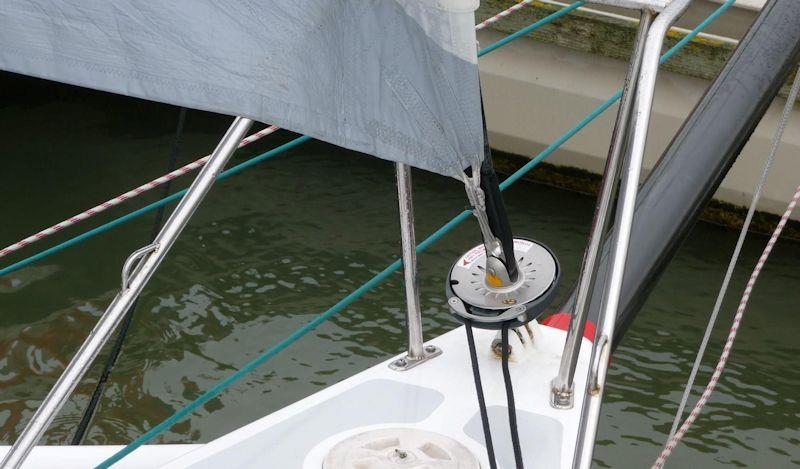
How Long is my Furling Line?
by Phil Anniss 3 Dec 2020 17:00 GMT

A structural furler © Karver
It's a simple question but if you are buying a new furler or need to organise a replacement furling line and do not have access to measure it....... how long should it be!?
In this article we give you some simple rules for estimating the required lengths of single or continuous loop furling lines.
Single versus continuous furling lines
All genoa reefing furlers, and some older style flying sail furlers, have a single furling line. By this we mean there is a single line leading back from the furling drum to the cockpit. The sail is unfurled by pulling on the sheets and as the sail comes out, the line gets wound onto the furling drum. To furl the sail, you release the sheets and pull on the furling line. Single line furlers only operate in one direction.
Continuous furling lines are generally used for code zero and asymmetric spinnaker furlers. They are a closed loop of line, created by splicing the two ends of a single line together, using what's called an "end to end" or "endless" splice. The loop runs once around the drum, which has teeth that grip onto the rope for furling. Continuous line furling systems can operate in either direction however, it is generally recommended to consistently furl in one direction, mainly to improve the performance of your torsional furling cable.
When we talk about furling line length: on a single line it is the end-to-end length of the line but for a continuous furling line we are referring to the loop length - e.g. a 12m continuous loop furling line is actually made of 24m of line (plus the length of the splice).
Single Furling Lines
There are three elements which go into estimating the required furling line length:
- Sail foot length
- Distance from drum to cockpit
- An adequate rope tail
The length of line going on/off the drum is simply the length of the sail foot. Then you just need enough line to run back to the cockpit and a spare rope tail. You may lead the furling line halfway down the side deck and directly into the cockpit or almost down to the transom, around a turning block and into the cockpit. As a rule of thumb, we therefore use the boat length, plus 20% as a tail.
Assuming you have a 150% genoa we can calculate approx. single furling line lengths for various boat sizes.
| Boat Length (ft) | 24 | 30 | 37 | 43 | 49 | 55 | 61 |
|---|
| Boat Length (mm) | 8000 | 10000 | 12000 | 14000 | 16000 | 18000 | 20000 |
| J (mm) | 2880 | 3600 | 4320 | 5040 | 5760 | 6480 | 7200 |
| Genoa LP | 150% | 150% | 150% | 150% | 150% | 150% | 150% |
| Tail (mm) | 1600 | 2000 | 2400 | 2800 | 3200 | 3600 | 4000 |
| Furling Line Length (mm) | 13920 | 17400 | 20880 | 24360 | 27840 | 31320 | 34800 |
| Furling Line Length (ft) | 42 | 53 | 64 | 74 | 85 | 95 | 106 |
At Upffront.com we use these as these as a good safe ballpark length, if we do not have detailed information on the cockpit layout. The good thing with single furling lines is that it is simple to cut them down by 1-2m if you find you have too much rope tail kicking around in the cockpit.
Continuous furling lines
With continuous furling lines there are various ways to set them up. On smaller boats some owners prefer to furl from the foredeck, whilst on open day-boats it is common for the crew to furl from just behind the mast. However, unless specified otherwise, we usually assume the continuous line will run down the side deck / stanchions and be furled from the cockpit. One common solution to keep the continuous lines tidy on the side deck is to use a snatch block and shock cord, tied back to the pushpit, to maintain some tension when the line is not in use.
Continuous loop length is very straight forward to estimate. Continuous line furlers are normally used on a bowsprit and so you need to take the distance from the furler to the "back of the bus", minus a length to allow a bungy take-up. Bowsprit lengths gradually increase with boat size from approx. 600 - 1200mm (up to 50-60ft boats) and for budgetary purposes we just use boat length for the overall loop length (the length of the bowsprit becomes the space at the back for the shock cord take-up).
Continuous furling lines are custom built therefore, 1) it's important that they are the right length but 2) they can be made to exact lengths based on your deck layout and preferred handling method.
Conclusion
For budgetary purposes or a safe bet:
- Continuous loop furling lines - your boat length is a good starting point
- Single genoa reefing lines - 175% of boat length works out as the magic number for a 150% headsail
However, with a deck layout and the above information you should be able to calculate your furling line length to a reasonable level of accuracy.
If you have any questions about your furling systems, please do not hesitate to contact us at or use our furling enquiry form.